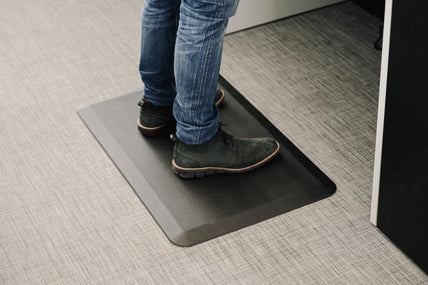How to Make Dual-Monitor Set-Ups More Ergonomic - Our Guide
By Daniel Angelini on December 22, 2020Dual-monitor set-ups: Whether you’ve been watching lots of streamers lately, looking at work-from-home (WFH) set-ups online, or venturing into computers, you’ve definitely heard of them at one point.
Originally linked to the gaming, coding, and computer engineering communities, dual-monitor set-ups have become a rising trend among remote workers who were forced to stay at home due to the pandemic. Although it may seem completely impractical to some extent, the truth is that having at least a two-monitor set-up in your workstation can make a whole lot of difference in your working experience.
Why should you consider adding an extra monitor to your set-up?
Currently, you might be thinking of investing in a dual-monitor set-up because it feels like a single monitor alone just won’t cut it for your productivity needs. Considering that dual monitors unlock an array of different opportunities that can greatly benefit your work life, it’s definitely worth considering the possibility of getting another screen to match your new one!
If you aren’t sure why you should invest in another monitor for your WFH workspace, here are three key benefits that are well worth considering:
Benefit #1: Elevated levels of productivity
One of the most critical benefits of using multiple monitors for your remote office set-up is that it can significantly boost your productivity levels.
With another monitor, it becomes far easier to get more things done because you won’t need to wait a bit to move between programs as you cruise through your workday. Once you get the hang of the set-up, you’ll be able to realise how much quicker you can get work done and the fact that faster work makes it easier to boost your task output each working day!
Benefit #2: Easier time focusing on any set of tasks
You might not realise it now, but the mere seconds (or minutes) that you spend waiting for programs to load up or adjust when you switch between digital workspaces severely compromises your focus.
When you spend at least a few seconds waiting for everything to load up, you essentially take yourself out of the zone and make it harder to jump back in the groove, resulting in lots of wasted time. Thankfully, opting to put another monitor in the mix will allow you to switch between applications and programs seamlessly without the risk of being distracted!
Benefit #3: Unhampered multitasking experiences
A primary benefit of dual-monitor set-ups that you’ll quickly realise and experience once everything is assembled into place is that they make it easier to multitask.
When you start working with an extra monitor, you essentially expand (or stretch) the current size of your digital workspace to accommodate more programs that will let you quickly switch back and forth. Instead of opening and closing programs repeatedly because of the limited space on a screen, you can keep all your programs running simultaneously and do everything at the same time without further difficulty!
The main problem of dual-monitor set-ups
At this rate, you’re probably sold on the idea of outfitting your workspace with an extra display that will help ensure you have everything you need to maximise and ease up your current situation.
After going through many options and sorting out which monitors suit your needs, you’re bound to end up at that point where you’re just a few clicks away from changing your workspace. Yet, before you hop in on this new experience, there’s one problem that you’ll need to address above all else: Such set-ups make it much easier to foster poor ergonomic habits that will increase pain and injury.
Avoiding ergonomic problems with the right tips
While it may be safe to say that dual-monitor set-ups do much good for your work life and boost your productivity levels, it’s also worth noting that they can be problematic for your body if you aren’t careful.
With more time spent in the chair and your neck’s flexibility constantly being pushed to its limits, adding another screen to your set-up will definitely increase your body’s likelihood of experiencing pain and injury. Thankfully, you can avoid such problems and maximise your productivity by considering these tips so that you can start working comfortably:
Tip #1: Opt for comfortable viewing distances
When it comes to ensuring that you can avoid neck and back problems after long hours working in front of a dual-monitor set-up, the first factor you’ll need to tackle is distance.
If you want to keep your ergonomics intact without worrying about any unwanted issues while working with your new set-up, the rule of thumb dictates that you should keep your monitors at an arm’s length distance. By putting your monitor in such a spot, you’ll have a much more comfortable viewing experience that won’t have you leaning forward or straining your eyes!
Tip #2: Learn to tilt for comfort
The one aspect of comfort that most first-timers to dual-monitors fail to account is that tilting the screens can make a significant impact on the level of comfort that they experience.
Seeing that screen angling has a direct correlation with one’s viewing posture, making even the smallest of adjustments can lead to significant improvements in your working ergonomics. While there may be many different options and angle measurements to play around with, tilting your displays at a 15-degree angle is an ideal way to improve your overall ease!
Tip #3: Close the gap
A common mistake that people make when building and using their dual-monitor set-ups is that they leave a sizable gap between the two screens.
It may not seem like such a big factor at first, but the presence of a gap between your monitors will severely impact your centring experience and cause you to over-exert your neck muscles on unnecessary movements. By closing the gap and keeping everything centred, however, you can reduce the side-to-side movement that you’ll need to make as you work day-in, day-out!
Tip #4: Invest in quality office furniture
Making a dual-screen set-up as ergonomic as possible is a 50-50 effort: one half is the adjustments that you make with the monitors themselves, and the other is the furniture you pair it up with.
Whether it’s your table, the chair that you sit on, or even the small wrist rests that you use, your choice of office furniture for your WFH set-up leverages a significant influence on the ergonomics of your set-up. Fortunately, going with a set of quality ergonomic options from Movi Workspace (such as our dual monitor arm), for instance, will help you avoid any unnecessary pains or awkward postures when adjusting to your dual monitors!
Conclusion
As helpful as dual monitor set-ups may be for any remote worker who is keen on improving their productivity, the fact remains that you can still run into some ergonomic issues along the way. With this guide’s help, you can improve your working experience, comfort, and productivity simultaneously with the right tips in mind!
Making the transition from a sedentary lifestyle to an active one at work can be quite complicated at times, but having the best standing desk set-up in Australia can make a world of difference. At Movi, we help businesses keep their workforces in active shape with stand up workspace technology – visit our online store today to learn more about our products!










